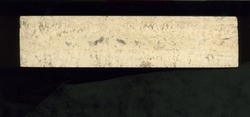| OUMNH Number: | 14 |
|---|---|
| Name and quarry location: | Travertino di Tivoli, travertino Romano, from Tivoli, Lazio, Italy |
| Geological description: | Porous banded travertine deposit, specimen cut parallel with the bedding. |
| Comments: | This is the traditional travertine widely used as a building stone in Rome since Ancient times. It is still being extracted from quarries near Bagni di Tivoli and Gudonia. A feature noted by Vasari is that when freshly quarried, it is relatively soft and easy to cut, but it becomes harder as it weathers over time. Although it is full of small cavities left where organic matter has decayed away, it is not particularly permeable and is consequently very durable. Travertino di Tivoli can take a polish and an excellent example of its modern use as an ornamental stone is in the interior of the British Library at St Pancras, London. Epoxy fillers are often used to fill cavities before polishing. 'Tiber Superbum' (2003) gives a detailed account of the history and use of this stone. |
| References: | Cappelli (1991); Corsi (1825); Corsi (1845) 75-76; Doehne (1996); Jervis (1889) 354-359; Pieri (c.1958) tav.XII; Porter (1907) 17-19; Price (2007) 58-59; Tibersuperbum (2003) |
| Further information: |
Alabaster-travertine.pdf |
| Corsi's classification: | Class 1. Marbles; Section 1. Monochrome marbles; Species 2. Palombinos |
|---|---|
| Corsi's text: | 26.3 Travertino di Tivoli. Marmor Tyburtinum. Il marmo Tiburtino volgarmente detto travertino |

